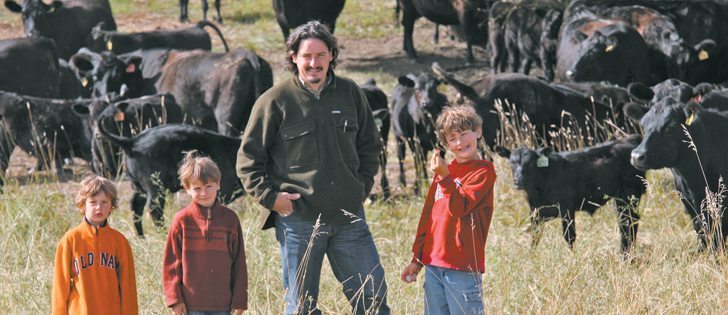Where some people saw grey wood soil, sloughs and trees that were hard to farm around, Christoph and Erica Weder saw potential.
The couple knew within half an hour of touring the house and five and a half quarters of land at the end of a northern Alberta road near Rycroft, Alta., that they had found the ideal cattle ranch.
“It was a diamond in the rough,” said Christoph, who came to Alberta’s Peace River region from central Alberta after severe drought in 2002.
“We liked it up here. We were willing to cut the umbilical cord and move to a place that gave us an advantage,” he said.
Read Also

Trump’s tariffs take their toll on U.S. producers
U.S. farmers say Trump’s tariffs have been devastating for growers in that country.
Their hard work and willingness to do things a little differently were recognized when the couple received Alberta Beef Producers’ environmental stewardship award this year for their dedication to creating a sustainable ranching operation.
“What we do on our land is try to improve the soil, add biodiversity and make a living with it,” said Weder.
Their belief that they needed to operate their ranch in a sustainable manner was cemented during a six month backpacking venture to Africa and South America before the move to northern Alberta.
“That really made us conscious of what we have in Canada and what a great place we live in. That set our philosophy of how we run this ranch,” he said.
The couple has fenced and cross-fenced the land, added legumes to all the pastures, put in an extensive watering system, plugged water drainage ditches to restore wetlands, pushed back calving time until May and June, kept the calves on the cows until March, wintered the cattle on pasture year round and stopped castrating the bull calves. All of this has added up to a profitable cattle ranch.
However, Weder said running a profitable and sustainable ranch is not just about putting a wire across a field. It’s a whole system. It’s the details of when to graze, how long to graze, how long to rest the pastures and the type of cattle genetics used on a grass-based ranch.
Six years ago, with rising grain prices and dropping beef prices, Weder could see the beef industry would be in trouble if it continued feeding high priced grain to low priced cattle. The search to find cattle that did well in a forage-based system was underway.
“We need genetics that do well on forage and not steered by the show ring.”
The search took him to New Zealand, where cattle are raised and fattened on grass. The Weders’ calves now need to be fattened on grain for only 60 days instead of the normal 120 days in a feedlot before slaughter.
“The genetics are better matched to our environment, and the cow herd can look after itself,” he said.
Building a cow herd that isn’t babied is also key to sustainability, said Weder.
The couple runs 1,000 head of Angus cattle on 15 quarters of deeded land and 28 quarters of grazing lease next to their Spirit View Ranch northeast of Rycroft. They recently bought a second ranch at Gordondale, about an hour west, with four deeded quarters and 10 rented quarters, where they run easy-maintenance Longhorn and Highland cattle bred to Angus bulls.
Weder said the devastating market crash in 2003, after the discovery of BSE in Canada, emphasized how vulnerable cattle producers were to the market. Cattle producers are only recently recovering from closed borders and lost markets.
It was during this time that the Weders and other producers formed Heritage Angus Beef to direct market high-quality, hormone-free beef to grocery stores and restaurants across Canada and around the world.
The meat is slaughtered at the European Union-approved Canadian Premium Meats plant in Lacombe, Alta. Sixty to 70 percent of the value of their animals is derived from exporting beef to Europe and other high-end markets.
“We get significant premiums for certain cuts and not much for others,” Weder said.
“You got to work at it.”
Weder said he didn’t know anything about a beef carcass and how it should be cut and priced when he started.
Maintaining and developing new markets is an ongoing task, and Weder is always looking for an edge. Three years ago, Heritage Angus Beef formed a partnership with Hero Burgers, a 37-restaurant chain that uses only Heritage Angus Beef in its burgers.
During discussions, Weder suggested the chain should take advantage of the fact that Heritage Angus Beef’s meat is butchered in an approved Halal method that allows Muslims to eat the hamburgers.
“That’s given them a huge edge in Toronto with the largest Muslim community in Canada. They’re excited to go to a restaurant and eat a burger without breaking rules,” he said.
In an effort to promote the less common cuts of meat, the Weders hired a chef and created their own cookbook, The Cook and the Cowboy. They printed it in English, Italian and German and made it available online.
“It’s the story of Canadian cattle with an international flair.”
Weder predicts that producing cattle on grassland that also supports wildlife and birds and is healthy for the environment will grow in popularity as the cost of grain increases.
“Cattle are going to be playing second fiddle to grain. The system based on feeding grain to cattle for more than 200 days is gone,” he said.
“We can raise cattle without outside inputs, except a little diesel to run trucks and machinery. We use no fertilizer and we’re not organic. There’s ways to do it in balance with nature.… Our plans are to keep growing. It’s not about growing to make more money. The driving factor is to take land and improving it and have it as a self-functioning system that makes a return with the cattle and improves habitat for wildlife.”















